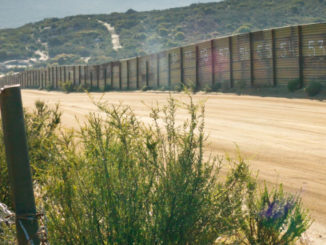
 Democratic State Rep. Rafael Anchia of Dallas heads the Texas House’s Committee on International Trade and Intergovernmental Affairs. Along with the Texas House’s Energy Resources Committee, his panel held a hearing in Edinburg, Texas on September 26 to discuss the potential impact of Mexican energy reforms on Texas’ economy and businesses. The Bush Institute spoke recently with Anchia about North American energy issues, as well as the flow of goods across the Texas/Mexico border.
Democratic State Rep. Rafael Anchia of Dallas heads the Texas House’s Committee on International Trade and Intergovernmental Affairs. Along with the Texas House’s Energy Resources Committee, his panel held a hearing in Edinburg, Texas on September 26 to discuss the potential impact of Mexican energy reforms on Texas’ economy and businesses. The Bush Institute spoke recently with Anchia about North American energy issues, as well as the flow of goods across the Texas/Mexico border.
We are reading a lot these days about Mexico opening its energy industry up to foreign investment. But, when it gets down to realities, what do you see as the potential in Mexico for Texas companies involved in the oil and gas industry?
The constitutional reforms that Mexico recently passed will most likely initiate a flurry of activity involving unconventional and offshore oil and gas exploration. Recent estimates indicate that energy production in the Burgos Basin of northern Mexico, where almost half of the 545 trillion cubic feet of Mexico’s recoverable shale gas resources are located, will be a staggering eight times bigger than that of Eagle Ford Shale. Given that Texas leads the world in this type of energy production and our state already maintains a mature, rules-based trade relationship with our neighbor to south, there will be significant opportunities for the export of oil and gas-related equipment and services from Texas to Mexico.
In addition, hundreds of energy companies call Texas home – 28 of them in the Fortune 500 – and many of them are industry leaders in the exploration and production of unconventional oil and gas. Mexico will benefit from the billions of dollars that Texas companies have made in research and development and the technological advances that are increasing the sustainability and efficiency of unconventional oil and gas recovery. Knowledge of unconventional exploitation, coupled with geographic proximity to the vast reserves in Mexico will provide a significant opportunity to companies that are operating in the Eagle Ford Shale gas formation in Texas.
What impact could that have on Texas’ economy?
The estimates on the economic benefits of collaboration are staggering: economists at BBVA report that, by 2018, as a result of Mexico’s energy reform, Texas is expected to gain more than 200,000 jobs, $3.4 billion in state revenues, and $45 billion in GDP. It is estimated that the Texas/Mexico border region, with approximately 30 million people, will bring in at least one-third of the earnings from the Mexican oil industry. This money will mean an economic boom to the smaller towns along the border, all of which have suffered from the disparities in income that typically exist between larger Texas towns and border towns.
A large share of foreign direct investment will be utilized to purchase both goods and services from Texas. If current trading trends between the U.S. and Mexico remain, the U.S. incremental foreign direct investment in Mexico will top $50 billion. Texas will prove to be the biggest beneficiary of this investment, with estimates of $10 billion being invested back into our goods and services.
Economic success within the energy industry will certainly spill over into other industries as well, particularly in areas such as housing and manufacturing. This will create more than $10 billion in additional economic activity, and add $2 billion in tax revenues for Texas.
And, as a result of these reforms and the resulting investment opportunities, Mexico’s economy is expected to grow at a rate of .8% per year. I look forward to witnessing how that growth will contribute to an economic boom, on both sides of the Texas- Mexico border.
The shale gas is impressive on both sides of the border, but how do you see it being sustained?
Whether or not the recent energy reforms in Mexico are successful will depend entirely upon how Mexico deals with the enormous challenges that will come as a result of a boom in shale activity. Some of the challenges, such as rulemaking and developing a regulatory regime, are technical in nature.
Others, as George Baker of Energia.com has testified, are adaptive, like eliminating the influence of the drug cartels in certain areas of Mexico. He has suggested that the increase in jobs connected to shale oil and gas can weaken the influence the cartels have.
Additional challenges will be the demand for improvements in water and wastewater infrastructure, electricity generating capacity and telecommunications services, as well as the increased need for housing, schools, and health care facilities. Texas has had some of the same challenges regarding infrastructure, and the two neighbors should work closely together so that Mexico can replicate what has worked in shale development areas such as the Eagle Ford Shale.
If these challenges are met, there is no reason that Mexico should not become a leader in shale oil and gas recovery, given that energy production in the Burgos Basin of northern Mexico is projected to be eight times bigger than that of Eagle Ford Shale.
Long waits at the U.S./Mexico border affect the flow of goods across North America. Since Texas cities like Brownsville, Laredo and El Paso are major crossing points, what would you like to see happen so that goods flow as efficiently as possible? As you know, this issue impacts what ends up in homes on both sides of the border.
At the first meeting in September of the Border Wait Times Committee, which I serve as co-chair, several solutions to solving the wait times issue were discussed. This issue is of paramount importance, as we now know that for every minute trucks are tied up at the border, $116 million is wasted in economic output.
Among the short-term solutions discussed at the hearing were: increasing the number of “fast lanes” that would give expedited release to importer trucks, separating privately-owned vehicles from commercial vehicles at ports of entry, avoiding duplications of inspections, and allowing more flexibility in the hours that ports of entry are open.
More long-term solutions would involve expanding or redesigning ports of entry, adding the number of bridges at ports of entry, increasing the number of inspectors and staff for all services at the ports of entry, providing training for agricultural specialists, and using technology to improve traveler information and provide an accurate measure of wait times and crossing times.
It has also been suggested that the private sector can help use the infrastructure that we already have, by more effectively synchronizing the activities of Mexican and U.S. customs and border enforcement officials at ports of entry.



